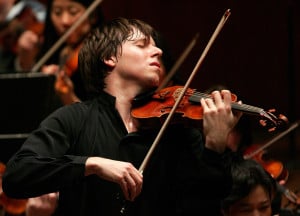Correction: In a previous version of this article, The Daily incorrectly reported that the second encore was a piece by Vitali. In fact, the second encore was Polonaise Brillante in D, Op. 4 by Henri Wieniawski. The Daily regrets this error.

Joshua Bell has been described as a “poet of violin,” a title he confirmed with gusto on Saturday night at Bing Concert Hall. Bringing life and drama to a program that featured musicians from disparate eras, from Giuseppe Tartini to Igor Stravinsky, Bell ravished the sold-out audience in a show that lasted almost two hours.
Bell’s world-class technique and stunning bow control created an effortless connection of musical lines in unusual and poignant ways. The violinist brought his very best on Saturday evening: not a single note was left unaccounted for, as he accentuated not just the clear musical cornerstones of each piece but also the minute tonal details.
Such characteristic skill was made apparent early on in the way Bell handled the cadenza at the end of the program’s first piece, Tartini’s “Sonata in G Minor.” Cadenzas, short inserts composed by the artist that exist for the sole purpose of showing off skill, are generally dramatic affairs that the artist purposefully disconnects from the rest of the piece as a demonstration of individuality.
Such overt validation of skill, however, was not necessary for Bell. He stopped neither at the start nor end of his cadenza, which consisted wholly of double-stop chords and involved strenuous string-crossings.
As the piano ceased its accompaniment for those few moments, the entire concert hall seemed to be holding their breath as the sound of Bell and his 1713 Huberman Stradivarius fully filled the cavernous space.
Bell’s performance of Tartini was energetic and dramatic, perhaps reflective of a composition written in response to a dream in which Tartini made a pact with the devil. While the very feat of playing the piece was meant to kill the violinist through pure exhaustion, Bell handled the second movement, a fury of four-string chords and too many trills to count, effortlessly.
Bell also played Beethoven’s “Violin Sonata No. 10 in G Major,” a piece composed half a century after the Tartini work. It was a more lyrical and serene piece, culminating in a surprising ending that left the audience in an ovation that lasted minutes.
The third piece in Bell’s performance was Stravinsky’s “Divertimento for Violin And Piano,” inspired by Tchaikovsky, whom the 11-year-old Stravinsky had the privilege of seeing only two weeks before his death.
Passive listening was not an option during the performance Bell’s powerful presence was immediately enthralling. He became one with the instrument, breathing according to the ebbs and flows, peaks and valleys of the musical landscape he was creating.
It was thrilling, as an audience member, to hear life breathed into the music as it bubbles into being. Perhaps the best example of Bell’s presence was his conclusions. Whether he whipped the bow across the instrument, fully extending his arm as if wielding a sword in the final blow of battle, or maintained the bow’s connection in perfect stillness, those final moments of silence following each piece’s conclusion were sacred ground.
Bell received an immediate standing ovation after the designated program was complete. He graciously surprised the audience by performing two more pieces: Rachmaninoff’s “Vocalise” and a show-stopping piece by Wieniawski. Another standing ovation followed, and all that could be heard leaving the auditorium were the awed responses from the mesmerized crowd.
Contact Elizabeth Woodson at ewoodson “at” stanford.edu.
